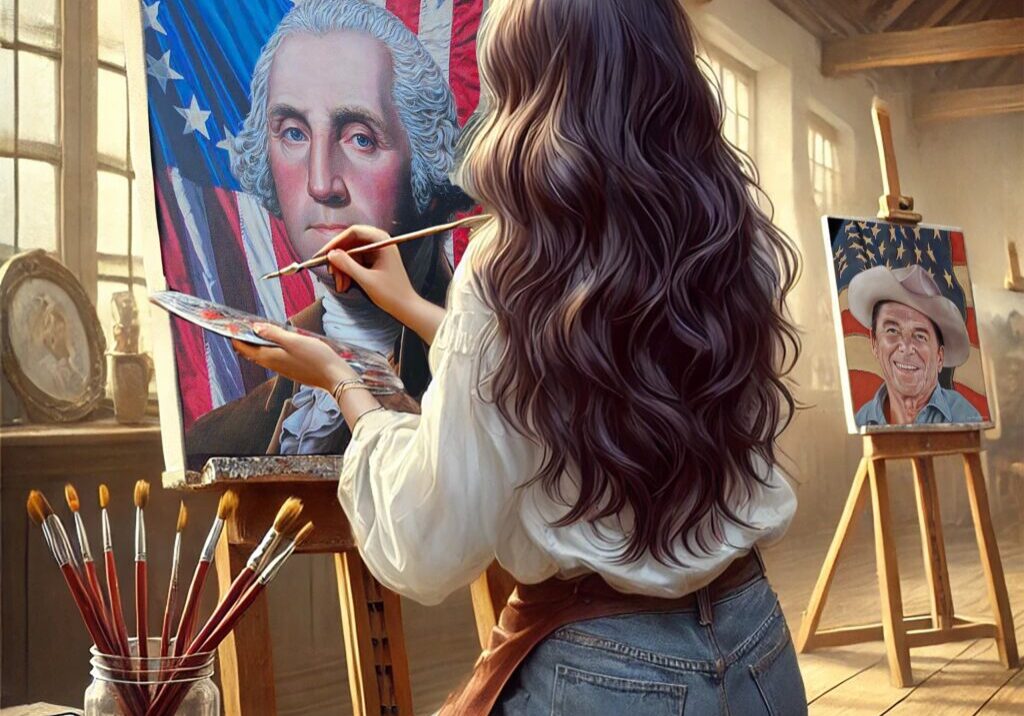
Layers of Liberty: The Technique and Symbolism of Rosemary Vasquez Tuthill
When I paint, I don’t start with the surface – I start with what’s beneath it. That may sound like a technical decision, and in part it is. But it’s also deeply symbolic. The 250th Anniversary Mural isn’t just about what we see on the surface of history. It’s about what’s layered underneath – the emotional residue, the untold contributions, the quiet decisions that made everything else possible. My technique follows that philosophy. I build the mural the way history builds itself: in layers. Every scene begins with a ground layer – usually a warm neutral tone that sets the emotional temperature of the section. I don’t leave this layer flat. I scumble and drag it slightly, letting some areas take on an unevenness. This gives me a living, breathing foundation. I want each surface to feel like it’s already seen something. Before any figure appears, the canvas has already begun telling a story. Next comes the underdrawing – not just for form, but for rhythm. I sketch not only the bodies and buildings, but the flow of energy. Where is the viewer’s eye likely to travel? What direction is tension moving in this frame? These lines may be covered in the final painting, but they guide the mood from the inside out. I often leave hints of them visible, like an echo beneath the finished scene. I layer paint slowly. Thin washes first, to establish atmosphere. Then glazes to deepen color, to build depth. Texture comes late, with dry brushing, palette knife work, or in some cases, subtle impasto on focal points. This isn’t just a method – it’s a metaphor. Revolutionary change didn’t arrive all at once. It was built, one choice on top of another. One gesture layered over hesitation. One word spoken louder than the last. Within each layer, I embed symbols. Not all of them are overt. A wrinkle in a tablecloth might mirror the shape of a colonial river. A shadow between two figures might carry the shape of a pine tree, quietly asserting an American identity. A fold in a poster might align with the arc of a musket barrel in another panel. These are not puzzles. They’re poems in paint. They reward curiosity but don’t demand explanation. Paper is one of the most symbolic objects in the mural, and I treat it that way. Every flyer, letter, proclamation, or discarded notice is layered with intention. I render them with delicate transparency or hard contrast depending on their meaning. A worn petition may blend softly into the background – its fading presence still part of the scene. A defiant handbill might carry a thicker line, as though the ink is still drying with resolve. Paper in the mural isn’t passive. It’s political. It moves through hands, air, history. Light, too, is layered. I rarely use pure white. Instead, I mix warm or cool highlights that respond to the emotional tone of the scene. I might wash a surface with pale gold to suggest hope, or use a colder blue to imply distance or loss. I layer these subtly so the light feels earned, not imposed. When light breaks through a window or falls across a figure’s face, I want it to feel like it belongs to the story. What I love about this approach is that each layer brings new meaning, even to me. Sometimes a mistake in the paint reveals something I hadn’t planned – a direction for a character’s gaze, a fold in a sleeve that looks like a turning point. I don’t erase those accidents. I listen to them. In a project this large, the painting often teaches me how to continue. Layers create time. They allow the mural to move beyond illustration and into resonance. A viewer may see a single figure at first, but as they look longer, they begin to see what that figure stands in front of. What they’re stepping toward. What’s been left behind in shadow. That’s where story deepens – not just in the subject, but in what surrounds it. So yes, I build the mural in layers – technically, emotionally, symbolically. Because liberty itself was never a single moment. It was the result of thousands of overlapping acts. My brush tries to honor that, one layer at a time.

